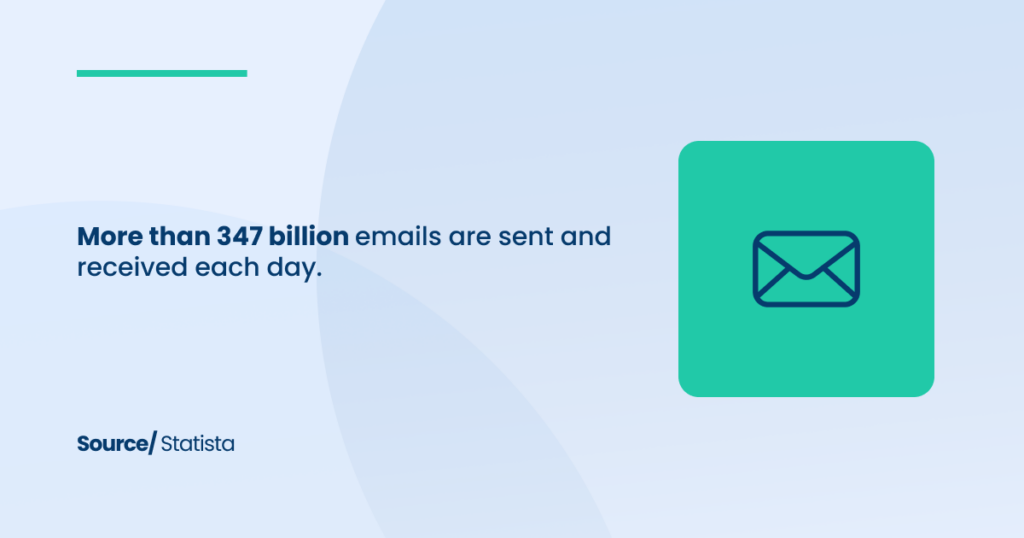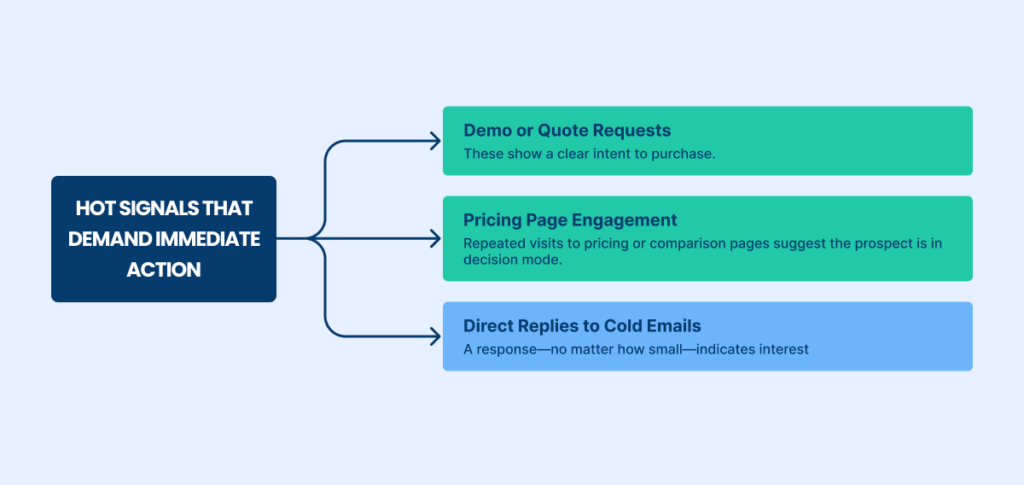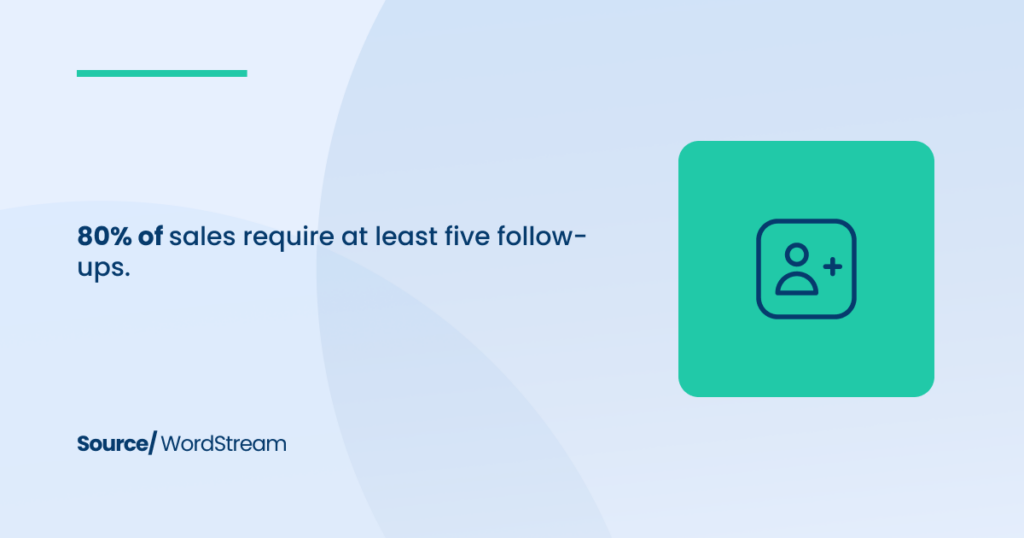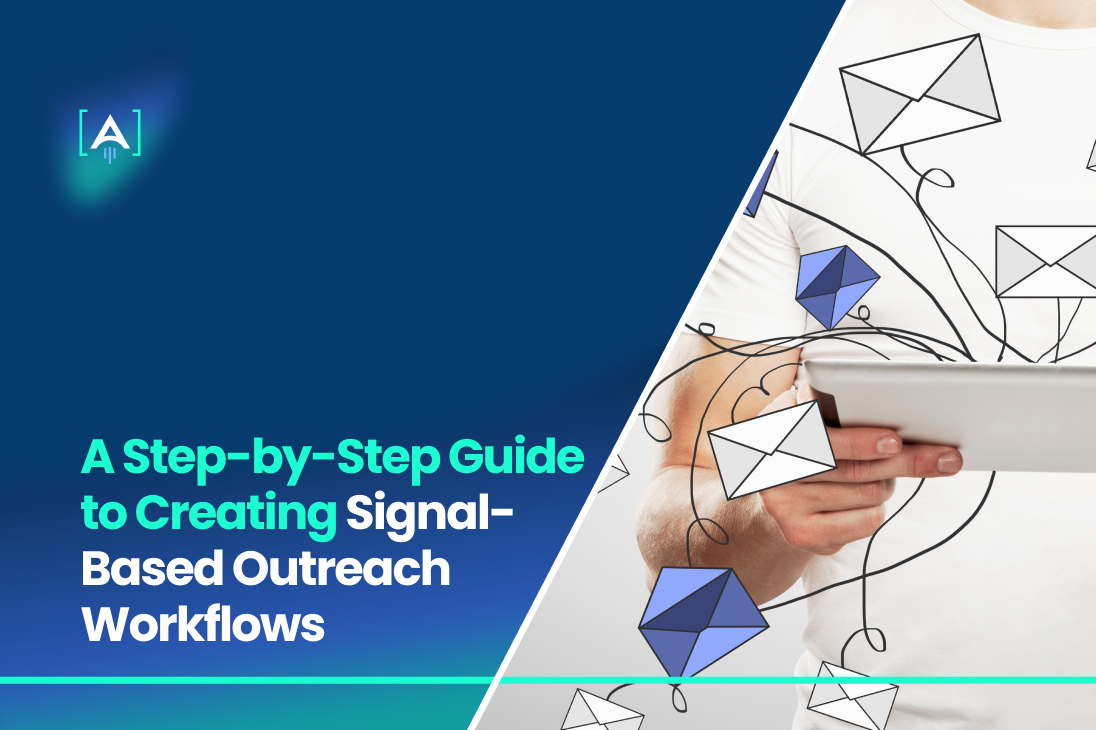Master Your Outreach: A Free Checklist for Signal-Based Workflow Optimization
Picture this: you’re walking into a crowded room, trying to converse.
Would you blurt out random facts to everyone, hoping someone listens? Or would you notice who’s already making eye contact and start a meaningful discussion with them?
That’s the difference between traditional outreach and signal-based outreach.
3 Essential Points for Signal-Based Outreach are:
- Leverage Real-Time Signals
- Prioritize Personalization
- Act at the Perfect Time

Simply shouting louder isn’t enough.
People are bombarded with emails, messages, and pitches every day, and most of them don’t even get a second glance.
Our Signal-Based Cold Outreach Services is here to change that narrative by increasing not only the volume but also the precision.
If you’re ready to stop guessing and start connecting with purpose, let’s dive into how signal-based outreach workflows can transform your approach.
Listening Before You Speak”: The Foundation of Signal-Based Outreach
Where competition is fierce and customer attention is fleeting, simply reaching out isn’t enough.
Cold outreach, whether through emails or LinkedIn, often ends up as noise unless it’s grounded in relevance. This is where signal-based outreach shines—it’s not just about talking; it’s about listening first.
Source: E-mail marketing revenue worldwide from 2022 to 2032, Statista
Statista highlights that the global e-mail marketing market was valued at 8.3 billion U.S. dollars in 2023.
Accordingly, by understanding what your customers want, need, or are actively looking for, you can tailor outreach workflows that resonate and convert.
What Are Signals, and Why Should You Care?
Think of signals as digital breadcrumbs left behind by your prospects. These clues, when analyzed, reveal whether they are ready to buy, exploring options, or simply gathering information.
Signals are split into three key categories:
- Pre-intent signals: Subtle signs that a prospect might need your solution in the near future. For instance:
- A company hiring cybersecurity specialists may soon require advanced security solutions.
- A retail chain announcing international expansion may need logistics support.
- Intent signals: Clear indicators of active interest in a solution. These include:
- Visits to your pricing page or product features.
- Downloads of whitepapers or case studies on your website.
- Engagement with industry-specific content, like blogs or webinars.
- Buying signals: Concrete actions suggesting readiness to purchase. These are the strongest cues, including:
- Requests for demos or product trials.
- Frequent visits to comparison pages on review sites like G2.
- Direct inquiries about pricing or contract terms.
Why do these signals matter? Because they tell you exactly who to focus on, when to engage them, and what message will resonate most. Instead of wasting time with generic cold email outreach, you can craft personalized outreach that aligns with their journey.
Listening Before You Speak: Why It’s More Effective
Most traditional cold outreach falls flat because it assumes rather than understands.
Sending blanket emails or LinkedIn messages often feels impersonal—and prospects can sense it. On the flip side, recognizing and acting on signals allows you to connect in a way that feels timely and relevant.
Here’s why this approach works:
- Relevance drives engagement: When a prospect receives a message that directly addresses their current challenge or goal, they’re more likely to respond.
- Timing is everything: Acting on signals quickly ensures you catch prospects at the peak of their interest, which can significantly boost conversion rates.
- Efficiency in targeting: Instead of casting a wide net, signal-based outreach focuses your efforts on the leads most likely to convert, saving time and resources.
Your CRM is a Goldmine – Are You Digging in the Right Spot?
For CEOs and business owners, time is precious, and so are your prospects. Your CRM isn’t just a database—it’s a treasure trove of insights waiting to be uncovered.
Yet many businesses barely scratch the surface, missing out on the powerful signals hiding in plain sight. If used wisely, your CRM can transform cold outreach into laser-focused, signal-based outreach that maximizes results.
Uncovering Signals Hidden in Your CRM
Every interaction your prospects have with your business leaves behind clues.
Your CRM is the perfect place to mine these signals and turn them into actionable data.
- Past Purchases and Order History
- If a client frequently buys one product, this might signal a need for complementary solutions.
- Example: A customer who consistently purchases entry-level tools may be ready to upgrade to a premium package.
- Engagement History
- Your CRM tracks every email opened, webinar attended, or blog clicked. These touchpoints provide valuable context for crafting personalized outreach workflows.
- Example: A prospect who has read multiple blogs on a specific topic is likely exploring solutions in that area.
- Frequent Page Visits
- Pages visited repeatedly, especially pricing or product features, indicate strong intent.
- Example: If a lead has visited your pricing page three times in a week, they’re actively considering your solution. This is the perfect time for targeted outreach.
AI as Your Outreach Detective
Mining data from a CRM is one thing.
Prioritizing and acting on those signals in real-time is another challenge altogether. That’s where AI tools like Clay, La Growth Machine, and Smartlead step in. These tools act as your digital detectives, analyzing signals faster and with more precision than any human could.
The Power of Real-Time Signal Tracking
AI tools can turn the chaos of scattered customer interactions into a streamlined flow of actionable insights.
Here’s how these platforms can supercharge your outreach workflows:
- Clay: Enriching Your Data Automatically
- Clay connects with your CRM and enriches your data with external insights.
- Example: It pulls details like job roles, recent LinkedIn activity, or company updates, giving you more context for personalized outreach.
- La Growth Machine: Multichannel Outreach on Autopilot
- This tool enables seamless multichannel outreach by automating email and LinkedIn outreach workflows.
- Example: After sending a cold email, La Growth Machine can automatically follow up on LinkedIn with a message that builds on your previous outreach.
- Smartlead: Prioritizing High-Intent Prospects
- Smartlead uses predictive analytics to rank leads based on their likelihood of converting.
- Example: If a prospect repeatedly opens emails about a specific product, Smartlead flags them as a priority, ensuring your team focuses their efforts on the most promising opportunities.
AI in Action: An Outreach Workflow Example
This is how a signal-based, AI-driven workflow might look:
- Step 1: Identify Signals
- Clay enriches your CRM with data showing a prospect has downloaded a whitepaper and viewed your pricing page twice.
- Step 2: Create Personalized Outreach
- Use La Growth Machine to send a cold email referencing the whitepaper and offering a tailored solution.
- Example Email:
“Hi [Name], I noticed you downloaded our guide on scaling operations. Many CEOs in your industry find our [Solution] helpful during growth phases. Would you like to explore it further?”
- Step 3: Automate Multichannel Follow-Up
- If there’s no reply, La Growth Machine follows up on LinkedIn with a message like:
“Hi [Name], just wanted to follow up on my email about scaling solutions. Let’s connect—I’d love to share how we’ve helped businesses like yours.”
- If there’s no reply, La Growth Machine follows up on LinkedIn with a message like:
- Step 4: Prioritize and Close
- Smartlead flags the prospect as high-intent after they engage with the follow-up. Your sales team schedules a personalized demo.
Timing is Everything: Acting on Signals at the Right Moment
Timing in outreach isn’t just important—it’s everything.
Signals tell you when a prospect is ready to engage, but if you don’t act fast enough or interpret them correctly, those opportunities vanish.
In a world where the average person receives hundreds of emails and messages daily, responding promptly and thoughtfully can be the difference between closing a deal and losing one.
The 5-Minute Rule: How Speed Can Make or Break Deals
In signal-based outreach, there’s a golden window where acting quickly transforms interest into opportunity.
Known as the 5-Minute Rule, this principle emphasizes responding to key signals like pricing page visits or demo requests within five minutes. Why? Because speed shows that you’re attentive, engaged, and ready to solve a prospect’s problem.
Why the Clock Is Ticking
- Signals Are Perishable: When a prospect views your pricing page or requests a demo, they’re actively thinking about your solution. Waiting too long allows distractions—or competitors—to steal their attention.
- Data-Backed: Studies reveal that responding within five minutes increases your likelihood of converting a lead by 400%. Contrast this with leads contacted 30 minutes later—they’re almost twice as unlikely to engage.
How Automation Can Help CEOs Stay Ahead
For CEOs juggling countless priorities, staying on top of every signal can feel overwhelming. This is where automated alerts step in.
Source: Marketing Charts
Tools like La Growth Machine or Smartlead can track signals in real-time, notifying your team the moment a prospect takes action.
How It Works:
- A prospect visits your pricing page.
- Your tool sends an instant alert to the sales team.
- A pre-drafted, personalized outreach email is sent within minutes, tailored to their specific interest.
Not All Signals Are Equal: Decoding Context Before Taking Action
While speed is crucial, not every signal demands immediate action. Misreading or overreacting to certain cues can lead to email outreach mistakes like seeming pushy or irrelevant.
To succeed in signal-based outreach, you must decode the context behind a signal to determine the best course of action.
Understanding Signal Context
Not all signals scream, “I’m ready to buy.” Some require nurturing,while others call for a direct approach. The key is distinguishing between intent, curiosity, and casual browsing.

Signals That Require Nurturing:
- Content Downloads: A whitepaper or e-book download may indicate early-stage interest. Instead of pitching, send additional resources.
- Social Media Engagement: Likes and comments are great for initiating dialogue but don’t immediately translate to intent.
- Email Opens Without Action: If a prospect opens your email multiple times but doesn’t click through, follow up with a soft touch.
Personalization at Scale: How to Keep the Human Touch
Personalization is no longer a luxury—it’s the expectation.
In a world flooded with generic emails and templated messages, standing out requires more than just addressing someone by name.
CEOs and business owners face a unique challenge: how to scale outreach without losing the warmth and authenticity of a personal touch.
Source: Customer experience personalization and optimization, Statista
Master Your Outreach: A Free Checklist for Signal-Based Workflow Optimization
From Robotic to Relatable: Crafting Conversations That Connect
Automation is powerful, but it can be a double-edged sword.
When misused, it strips communication of humanity, leaving recipients feeling like just another number in a database. The key is to use automation to enhance your ability to connect, not to replace it.
Dynamic tokens are one of the most effective tools for achieving this balance. By pulling real-time data—such as a recipient’s name, company, or recent achievement—you can craft tailored opening lines that feel authentic.
For example, instead of a generic “Hi [Name], hope you’re well,” try “Hi Sarah, congratulations on your company’s recent expansion! Scaling operations is no easy feat, and I’d love to share some insights that could help.” This approach instantly signals that the message isn’t just another mass email.
But personalization isn’t just about mentioning names or milestones. It’s about understanding the context.
Signals like visits to pricing pages, downloads of whitepapers, or engagement on LinkedIn reveal what matters to your prospects. When crafting outreach workflows, focus on addressing these pain points directly.
For instance, if a recipient has been exploring content about streamlining operations, your email should reflect their interest: “I noticed you’ve been looking into strategies for optimizing workflows. Let’s discuss how our solutions could save you time and resources.”
By combining automation with thoughtful cues, you can ensure every interaction feels intentional and personal. This balance doesn’t just improve cold email open rates—it builds trust and fosters meaningful engagement.
Email Templates That Don’t Feel Like Templates
Templates often get a bad rap for being impersonal, but when used wisely, they can be a game-changer in cold email outreach.
The secret lies in how you craft them. AI-generated personalization, powered by tools like La Growth Machine or Smartlead, allows you to scale outreach while maintaining your brand’s human voice.
Start by thinking of your template as a conversation starter, not a script. Avoid language that sounds robotic or overly formal. Instead, write as if you’re speaking to someone directly.
For example, instead of saying, “We offer solutions to enhance your operational efficiency,” opt for “I’d love to share how we’ve helped businesses like yours simplify operations and achieve better results.”
Every email template should also include an element of curiosity or intrigue.
Personalized email subject lines are critical here. Data shows that subject lines with an emotional hook or direct relevance to the recipient’s interests significantly boost open rates. An example could be: “Struggling with workflow inefficiencies? Here’s a quick fix.”
AI can help here by generating multiple versions of subject lines and body text tailored to different signals.
For example, if a prospect has engaged with content about multichannel outreach, your email could lead with: “Optimizing Multichannel Outreach for Results That Matter.” On the other hand, if their activity suggests interest in signal-based outreach, a subject like “Ready to Unlock the Power of Signals?” would resonate more.
Start with the End in Mind: What’s Your Goal?
Imagine trying to hit a target while blindfolded—it’s not just frustrating, it’s inefficient. That’s what happens when businesses dive into outreach workflows without clear goals.
For CEOs, the stakes are high: every decision shapes the company’s growth, retention, and profitability. To make the most of signal-based outreach, you need to know what success looks like before you even begin.
Start by asking yourself, What am I trying to achieve? Are you looking to generate leads, upsell existing customers, or boost retention?
Each objective requires a tailored approach. For example, lead generation workflows might focus on identifying signals from first-time visitors, like downloads or pricing page views. On the other hand, upselling relies on engagement signals from existing customers—like repeated visits to premium product pages.
Turning Data into Action: Map the Customer Journey
Once you know your goal, the next step is understanding the journey your customers take to get there.
In signal-based outreach, this journey isn’t a straight line—it’s a series of triggers, actions, and responses. The magic lies in mapping these steps so you can meet your prospects at exactly the right moment.
Every interaction leaves a breadcrumb of data—signals that tell you where a prospect is in their journey.
For example, a first-time visitor clicking through a blog post is in the awareness stage. A demo request? That’s a buying signal. By mapping these interactions, you can create workflows that guide prospects from interest to action.
Here’s how it works: start by identifying key touchpoints along the customer journey. These might include website visits, email opens, or engagement on LinkedIn. For each touchpoint, define a trigger—something that signals the need for action.
For instance, a pricing page visit might trigger a follow-up email with detailed pricing options. Similarly, repeated engagement with educational content could signal readiness for a deeper conversation.
The Follow-Up Formula: Don’t Let Leads Slip Away
A well-crafted outreach workflow doesn’t end with the first message—it thrives on timely, relevant follow-ups. Yet, one of the most common mistakes in cold outreach is failing to follow up.

For CEOs, this represents a significant missed opportunity.
The key to effective follow-ups lies in signal-based outreach. Not all signals demand the same response, and understanding their context is critical. For example, a demo request requires immediate attention—ideally within five minutes.
Delaying beyond that risks losing the prospect’s interest. On the other hand, a content download might call for a nurturing approach, like a follow-up email offering additional resources.
Timing isn’t the only factor; relevance matters just as much.
Each follow-up should build on the previous interaction, adding value without feeling pushy.
For instance, if a prospect engages with a case study, your next message might highlight similar success stories or offer a personalized consultation. This approach shows you’re paying attention, making your outreach feel thoughtful rather than transactional.
From Signals to Success: Turning Outreach into Opportunity
Creating signal-based outreach workflows is more than just implementing a strategy. It’s about redefining how you connect with prospects and customers.
[A] Growth Agency will build bridges that turn curiosity into conversations and interest into action. Our team will guide your outreach, ensuring every message hits the mark.
We’re a team of data-driven growth marketers focused on delivering scalable results.
Excellence is our standard. We believe in the power of data to inform and drive every strategy, ensuring our actions are as effective as they are innovative.
We don’t just follow trends—We innovate and adapt.

